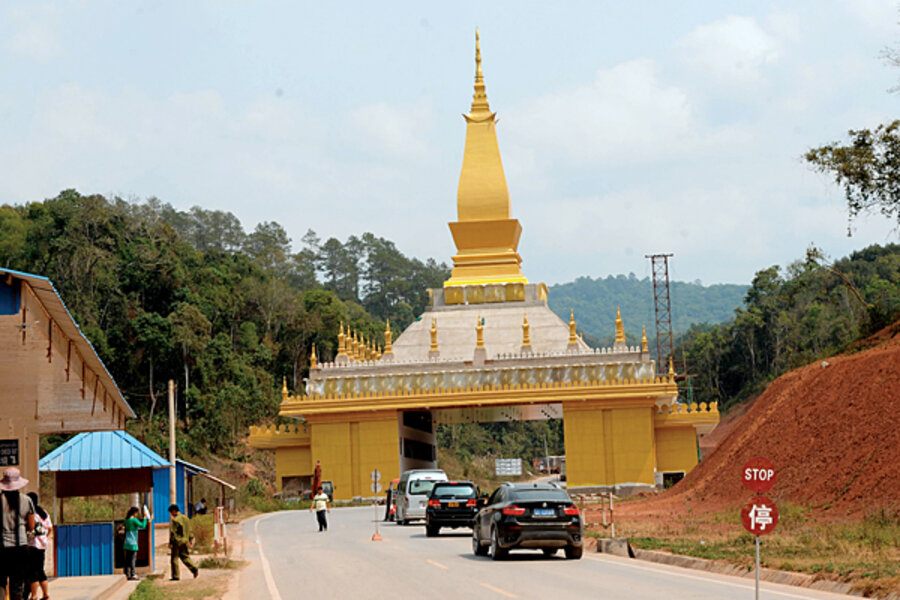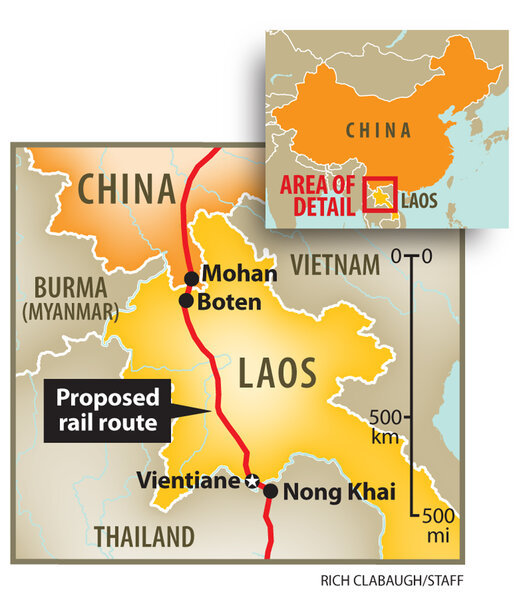China pushes rail links into southeast Asia: Is Laos aboard?
Loading...
| Boten, Laos
At first, the villagers saw only the upside: A new high-speed train was coming to Laos from China, its giant neighbor. It would put their corner of northern Laos on the map and bring investment to this poor, landlocked country.
Then the Laotian government officials showed up and explained that much of the village, relocated in 2005 to make way for a Chinese casino, would have to move again. In March, a team of Chinese engineers began surveying the lush valley and hillsides, which lie on the railroad's planned 261-mile route south to the capital, Vientiane, from the nearby border.
The plan to requisition a large tract of land was a shock, says village chief Kamthoeun Kaewvongphait. The railroad looked so sleek and narrow in computer simulations shown on television that villagers reckoned it could pass through their community without too much disruption. Now some 1,000 people face another imminent move, and nobody knows when it might be.
While some villagers complain privately that they are getting a raw deal, Mr. Kamthoeun puts on a brave face. "We need to develop our country and make it modern. I think that it's good, and we can move our homes," he says.
If it goes ahead, the high-speed train would spell change for Laos, a rural backwater that has been bypassed by Asia's industrial boom. Its price tag of $7 billion is more than the country's annual economic output. China is expected to finance and build the railroad, which is designed to link to an upgraded rail network in Thailand and then to Singapore, boosting southwest China.
The ambitious project underscores the growing Chinese presence in Communist-ruled Laos, which has long depended on Western aid. Chinese firms are investing in tourism, agriculture, and mining, and Laotians are busy studying Chinese and learning how to do business with China.
In February, however, the railroad appeared to run into delays after China's powerful railways minister was fired for corruption, raising questions over political support for its completion by 2015. A planned groundbreaking ceremony in April was postponed, and a Laotian government official said that China's "ministerial reshuffle" was to blame but insisted that it would go ahead. Villagers in Boten said they'd not been told of any delays.
The announcement in December of a high-speed railroad through Laos came as a surprise to governments in the region that had been working on other ways to improve their transport links. The Association of Southeast Asian Nations (ASEAN), to which Laos belongs, has tried to boost rail connectivity with China and seek support from international donors, with limited success.
Potential game changer
China's willingness to build a railroad in Laos is a potential game changer, says Ruth Banomyong, an associate professor of logistics at Thammasat University in Bangkok, Thailand, and an expert on regional transportation. But it has a downside for governments that had pushed for a broader ASEAN rail network via other countries.
"The Chinese have their own agenda. Some of this does match with the ASEAN agenda, but other parts just serve China," Mr. Banomyong says.
One beneficiary would be Thailand. Its government has begun negotiating with China on a joint project to add a connecting high-speed line along an existing route from Bangkok to the Thai-Laotian border, where a railway bridge spans the Mekong River.
In theory, this would allow passenger trains from Bangkok to pass at speeds of up to 125 miles per hour over the agricultural belt of northeast Thailand and up through the rugged mountains of northern Laos to the Chinese border. Cargo trains would travel at slower speeds but are likely to be the main user of the lines.
For villagers in Boten, such seamless travel is an almost unimaginable leap from the bumpy bus rides they currently endure. Some are hopeful that a railroad means new customers to buy their farm goods, though they're not sure where the train will stop. "It's good to build a railroad. I want to see the train coming here because it can improve our lives," says Bundi Pinlabong, a villager whose house isn't on the route.
Could Laos be relegated to a transit country?
But critics point out that Laos could be relegated to a transit country for fast trains bound for Bangkok and Singapore, which have far more to offer China. Others warn that Laos may award Chinese companies mineral concessions in return for the railroad, adding to the social and environmental disruption from the project.
Chinese investors have already caused a stir here with their casino complex, which was built on land where villagers once farmed corn and vegetables. Known as Golden City, the casino attracted thousands of Chinese gamblers and created jobs for local residents, but ran into trouble last year after casino operators refused to let indebted gamblers return home. Most gaming operators have since shut down under pressure from China's government, leaving hundreds of Laotian croupiers out of work.



